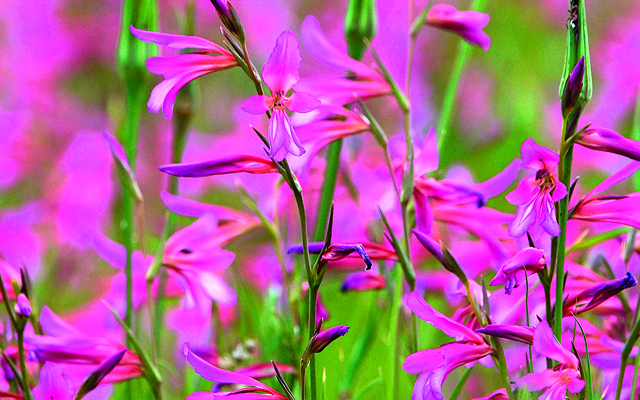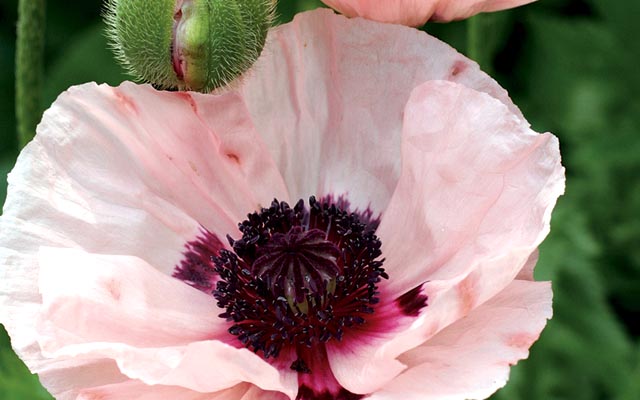Why Mediterranean flowers lift the spirits
David Wheeler explores the abundant flora of Cyprus.


It’s an easy hop from Istanbul to Cyprus. An hour’s flying has you descending over the Taurus Mountains of southern Anatolia, cruising over the 40-mile stretch of sapphire-blue water from which the Kyrenia Mount-ains rise along the island’s north shore. It was late March last year when I left Istanbul’s leafless urban landscape, after three weeks of Ottoman garden-spotting. By then, I was ready for the softer delights of the Mediterranean and the promise of wildflowers too numerous to count. What’s to be seen there, at this time of year?
Turkish-speaking North Cyprus occupies about a third of the island’s landmass, including the Karpas Peninusula, where wild donkeys still forage among the dunes. But I was heading for the foothills between the cedar- and pine-clad Gothic heights of Buffavento and St Hilarion, each rising to some 3,000ft and where, at lower levels, the limestone maquis nourishes wild orchids.
Within minutes of arriving at Bellapais the setting of Lawrence Durrell’s autobiographical Bitter Lemons and where he lived for three years in the mid 1950s I was out among the goats nearby, ticking off orchid species on a scrap of paper on which I had also scribbled the names of other hoped for trophies among the muscari, tulips, asphodels, gladioli and cyclamens. Pink- and white-coloured cistus were flowering; the globular flowerheads of rampant giant fennel and naturalised mimosa trees revved up the yellow, effortlessly competing with a dazzling sun that rode a cloudless blue sky.
My guide, debonair polymath Sabri Abit, is co-owner of the simple, yet sumptuous, Bella-pais Gardens Hotel where I was lodged; he knows his terrain intimately. We found just five orchid species that first afternoon, including pink-flowered Orchis italica, the naked man orchid with, yes, its distinguishing appendage. Alas, the earlier-flowering giant orchid, Barlia robertiana, could only be recognised by its remnant seedheads.
Later in the week, further west, among juniper and arbutus groves above Lapta, in the company of yet another local expert, Fethi Ozbogac, I added to my orchid tally another six of the island’s 50 species. Aspho-dels were dominant among them and Cyclamen persicum was common everywhere, almost to the tidemark by the ancient rock graves on the beach at Lambousa.
Fethi also took me to the remarkable 30-year-old Cactus Garden made by graphic designer, art teacher and formidable plantsman Hikmet Uluçam. But cactus admittedly numbering some 500 different kinds is only part of Hikmet’s wonderland. Before passing through his gate, I could see the blanket covering of cyclamen, anemones, poppies and ranunculus clothing the ground beneath his untamed ‘orchard’.
I filled a page of my notebook with his fruit and nut trees: citrus of several kinds, pistachio, pomegranate, loquat, mulberry, fig, quince, peach, apricot, olive, banana, avocado and prickly pear. Tucked between rocks and paving lurked two endemics: low-growing pink-suffused Arabis cypria and the startling merlot-red Tulipa cypria, growing to a height of about 15in.
Sign up for the Country Life Newsletter
Exquisite houses, the beauty of Nature, and how to get the most from your life, straight to your inbox.
‘Would you like to see more of this tulip?’ asked Hikmet. As they’re among my treasured genera, I wasn’t about to say no. After lunch in the garden at Fethi’s nearby Lapida Hotel (where he, too, grows some 40 different fruit-bearing trees), we set off. Our goal was the northern slope of a low hill planted with barley, already ripening under the late-March sun.
There, in about a quarter-acre patch, as plentiful as Flanders poppies, was a horde of Tulipa cypria, rising from bulbs supposedly as much as a yard deep, in soil turned by the plough every year. Where the tulips petered out by the gravelly track, there grew some small blue irises and the alluring magenta spears of Gladiolus italicus. ‘You like these?’ asked Hikmet. ‘Come.’
We drove to a Maronite Christian village where, alongside an unbelievably small church (measuring in length just 11 of my paces by five wide), were two fields of these most seductive of wildflowers. North Cyprus, we agreed, is surely among the most bounteous of floral havens in the entire Mediterranean.
Join us in the Italian gardens of Russell Page
Visit northern Italy's horticultural treasures on the Country Life Italian-garden tour.

The best poppies to plant in spring
And they called it poppy love.
Country Life is unlike any other magazine: the only glossy weekly on the newsstand and the only magazine that has been guest-edited by HRH The King not once, but twice. It is a celebration of modern rural life and all its diverse joys and pleasures — that was first published in Queen Victoria's Diamond Jubilee year. Our eclectic mixture of witty and informative content — from the most up-to-date property news and commentary and a coveted glimpse inside some of the UK's best houses and gardens, to gardening, the arts and interior design, written by experts in their field — still cannot be found in print or online, anywhere else.
-
 Vertigo at Victoria Falls, a sunset surrounded by lions and swimming in the Nile: A journey from Cape Town to Cairo
Vertigo at Victoria Falls, a sunset surrounded by lions and swimming in the Nile: A journey from Cape Town to CairoWhy do we travel and who inspires us to do so? Chris Wallace went in search of answers on his own epic journey the length of Africa.
By Christopher Wallace
-
 A gorgeous Scottish cottage with contemporary interiors on the bonny banks of the River Tay
A gorgeous Scottish cottage with contemporary interiors on the bonny banks of the River TayCarnliath on the edge of Strathtay is a delightful family home set in sensational scenery.
By James Fisher